Differential effects of 5-HT(2A) and 5-HT(2C) receptor blockade on strategy-switching
- PMID: 21232556
- PMCID: PMC3113532
- DOI: 10.1016/j.bbr.2010.12.031
Differential effects of 5-HT(2A) and 5-HT(2C) receptor blockade on strategy-switching
Abstract
Recent experiments indicate that blockade of serotonin (5-HT) 2A and 2C receptors have differential effects on reversal learning. The present experiments investigated the effects of the 5-HT(2A) receptor antagonist, ketanserin and 5-HT(2C) receptor antagonist, SB242084 on acquisition and strategy-switching in a visual cue-response paradigm. Long-Evans rats were trained in a cross-maze to enter an arm based on color (visual cue version) or a specific turn response (response version). Systemic treatment with ketanserin did not affect initial learning of a visual cue or response discrimination, but ketanserin at 0.5 mg/kg significantly enhanced a switch between visual cue and response strategies. Ketanserin facilitated strategy-switching by inhibiting responses to a previously relevant strategy without affecting choices to never-reinforced strategies. Treatment with SB242084 (0.5, 1.0 or 2.0 mg/kg) did not affect acquisition of a visual cue or response discrimination. SB242084 treatment also did not affect strategy-switching. The present findings suggest that blockade of 5-HT(2A), but not 5-HT(2C), receptors enhance strategy switching.
Copyright © 2011 Elsevier B.V. All rights reserved.
Figures
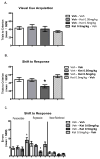
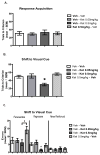
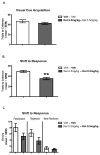
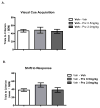

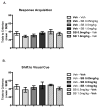
Similar articles
-
Opposing roles for 5-HT2A and 5-HT2C receptors in the nucleus accumbens on inhibitory response control in the 5-choice serial reaction time task.Neuropsychopharmacology. 2008 Sep;33(10):2398-406. doi: 10.1038/sj.npp.1301636. Epub 2007 Nov 28. Neuropsychopharmacology. 2008. PMID: 18046307
-
Ejaculatory response induced by a 5-HT2 receptor agonist m-CPP in rats: differential roles of 5-HT2 receptor subtypes.Pharmacol Biochem Behav. 2008 Feb;88(4):367-73. doi: 10.1016/j.pbb.2007.09.009. Epub 2007 Sep 18. Pharmacol Biochem Behav. 2008. PMID: 17936345
-
Effects of 5-HT(2A) and 5-HT(2C) receptor antagonists on acute and chronic dyskinetic effects induced by haloperidol in rats.Behav Brain Res. 2011 Jun 1;219(2):273-9. doi: 10.1016/j.bbr.2011.01.025. Epub 2011 Jan 22. Behav Brain Res. 2011. PMID: 21262266
-
Cocaine acts on accumbens monoamines and locomotor behavior via a 5-HT2A/2C receptor mechanism as shown by ketanserin: 24-h follow-up studies.Prog Neuropsychopharmacol Biol Psychiatry. 2004 May;28(3):547-57. doi: 10.1016/j.pnpbp.2004.01.007. Prog Neuropsychopharmacol Biol Psychiatry. 2004. PMID: 15093963
-
Dissociable effects of selective 5-HT2A and 5-HT2C receptor antagonists on serial spatial reversal learning in rats.Neuropsychopharmacology. 2008 Jul;33(8):2007-19. doi: 10.1038/sj.npp.1301584. Epub 2007 Oct 24. Neuropsychopharmacology. 2008. PMID: 17957219
Cited by
-
Psilocybin therapy increases cognitive and neural flexibility in patients with major depressive disorder.Transl Psychiatry. 2021 Nov 8;11(1):574. doi: 10.1038/s41398-021-01706-y. Transl Psychiatry. 2021. PMID: 34750350 Free PMC article.
-
Neuromodulation of Attention.Neuron. 2018 Feb 21;97(4):769-785. doi: 10.1016/j.neuron.2018.01.008. Neuron. 2018. PMID: 29470969 Free PMC article. Review.
-
The rat's not for turning: Dissociating the psychological components of cognitive inflexibility.Neurosci Biobehav Rev. 2015 Sep;56:1-14. doi: 10.1016/j.neubiorev.2015.06.015. Epub 2015 Jun 22. Neurosci Biobehav Rev. 2015. PMID: 26112128 Free PMC article. Review.
-
Cognitive set shifting deficits and their relationship to repetitive behaviors in autism spectrum disorder.J Autism Dev Disord. 2015 Mar;45(3):805-15. doi: 10.1007/s10803-014-2244-1. J Autism Dev Disord. 2015. PMID: 25234483 Free PMC article.
-
Cognitive flexibility impairment and reduced frontal cortex BDNF expression in the ouabain model of mania.Neuroscience. 2017 Mar 14;345:229-242. doi: 10.1016/j.neuroscience.2016.05.058. Epub 2016 Jun 4. Neuroscience. 2017. PMID: 27267245 Free PMC article.
References
-
- Baumgarten HG, Grozdanovic Z. Role of serotonin in obsessive-compulsive disorder. Br JPsychiatry. 1998;(Supplement 35):13–20. - PubMed
-
- Berberian AA, Trevisan BT, Moriyama TS, Montiel JM, Oliveira JA, Seabra AG. Working memory assessment in schizophrenia and its correlation with executive functions ability. Rev Bras Psiquiatr. 2009;31(3):219–226. - PubMed
-
- Bojarski AJ. Pharmacophore models for metabotropic 5-HT receptor ligands. Curr Top Med Chem. 2006;6:2005–2026. - PubMed
Publication types
MeSH terms
Substances
Grants and funding
LinkOut - more resources
Full Text Sources

